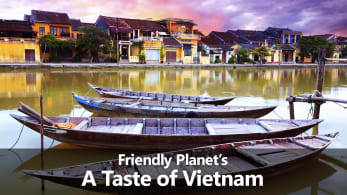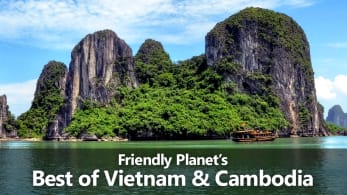 Vietnam
Vietnam
Vietnam is full of unexpected, marvelous sights: vast, green rice terraces fill the landscape, dotted by numerous conical hats of local farmers. A country of seemingly endless farmland is interrupted by massive cities with vibrant nightlife. Centuries-old temples and decorated pagodas are found at every turn, including a tiny one that stands on one leg in the center of a lotus pond. Bustling markets full of colorful, fresh fruits and patterned trinkets can be found only a short walk from ornate French colonial buildings, community squares, and neatly kept public gardens.
Tours & Packages
- Destinations: Vietnam
- including closed packages

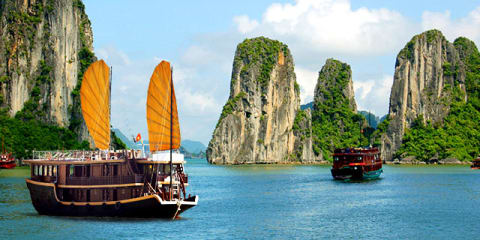
Trip Reviews & Photos
We love hearing your stories and seeing your photos! Check out our entire fan photo gallery and upload your photos.
Highlights
- Ho Chi Minh City
Commonly known as Saigon, this city in southern Vietnam was renamed Ho Chi Minh City in 1976 when Saigon merged with the Gia Dinh Province. Ho Chi Minh City perfectly illustrates its past and future -- full of towering skyscrapers and charming tree-lined streets. Famously known for its importance during the Vietnam War, the city is also recognized for its French influence scattered throughout. Some great examples of this influence are the Notre-Dame Cathedral, created solely with French-imported materials, the ornate French colonial Saigon Post Office that famous architect Gustave Eiffel built, and Reunification Hall, which formerly served as the Presidential Palace. Take time to visit one of the earliest surviving structures in Saigon -- Bến Thành Market. This bustling market is full of stalls and vendors selling local handicrafts, textiles, souvenirs, and cuisine. Some of the top street foods in Ho Chi Minh City are Vietnamese sandwiches, southern-style southern pancakes, and broken rice.
- Hanoi
Founded over 1000 years ago on the banks of the Red River, Hanoi is the capital of Vietnam (and one of the most ancient capitals in the world!) known for its centuries-old architecture and a rich culture with influences stemming from Southeast Asia, China, Russia, and France. This city is also famous for its decadent cuisine, lively nightlife, handmade crafts and silks sold in the markets, and more. With the streets of its bustling 14th-century Old Quarter, Hoan Kiem lake that lies in the heart of the capital, Ho Chi Minh's Mausoleum and his private residence, and more, Hanoi illustrates the history of Vietnam perfectly. Additionally, this capital city is home to the famous Temple of Literature, Vietnam's first university, and Hoa Lo Prison, also known as the "Hanoi Hilton."
- One Pillar Pagoda
The One Pillar Pagoda, located in Hanoi, is a historic Buddhist temple and one of Vietnam's most iconic temples. Built by King Ly Thai, this architecturally unique structure lies on a single stone pillar in the middle of a lake built to represent a lotus (also Vietnam's national flower). According to legend, the king would visit numerous temples, praying to Buddha for a son of his own. He once dreamed of the bodhisattva Avalokiteshvara seated on a giant lotus flower in the middle of a square pond. He was holding a baby boy that he then gifted to the king. Months after this dream, the queen gave birth to a little boy. With this exciting miracle, the king commissioned the One Pillar Pagoda in 1049, which resembled a giant lotus emerging from the water.
- Cu Chi Tunnels
The Cu Chi Tunnels is an elaborate network of underground tunnels located in the Củ Chi District of Ho Chi Minh City and built by the Viet Minh in the 1940s. These tunnels once stretched over 200 miles and contained tactical quarters, storage rooms, kitchens, a school, and a hospital. The purpose of this underground system was to help the Vietnamese protect themselves and fight against the more well-equipped American and South-Vietnamese soldiers during the Vietnam War. The Vietnamese soldiers dug out and utilized these tunnels to house troops, transport supplies from place to place, house booby traps for enemies, and more. Most entrances to these tunnels were so well disguised that only a tiny portion of the system was ever discovered during the war. American and South-Vietnamese soldiers, known as "tunnel rats," were trained to explore the tunnels to find booby traps and enemies. Today, the Cu Chi Tunnels are in a Vietnam War memorial park and have become a popular tourist attraction; you can descend into some tunnels to see for yourself!
- Halong Bay
Halong Bay is a UNESCO World Heritage site adorned with thousands of limestone karsts and isles in the Gulf of Tonkin. The bay is popularly known for its sparkling emerald-green waters that are home to over 1,600 islands, mostly uninhabited. According to ancient legend, invaders came to the area to try and claim the land. To protect the land and its inhabitants, the Jade Emperor directed the Mother Dragon down to Earth to assist the locals in fighting against the invaders. As she defeated the enemies, the Mother Dragon scattered down emeralds, eventually becoming the towering limestone formations that still stand today. The name "Halong Bay" originated from this legend since "Halong" means "descending dragon." The bay is a popular destination for scuba diving, rock climbing, and hiking, especially near Cat Ba National Park.
- Temple of Literature
The Temple of Literature, Vietnam's first university, was built in 1070 during the time of Emperor Lý Thánh Tông and was closed in 1779. Today, the well-preserved architecture and gardens (that are still cared for just as they were hundreds of years ago!) paint a picture of Vietnam's past. In the university's early days, the students that attended the Temple of Literature were members of the elite class who studied literature, poetry, and Chinese philosophy. The university is divided into five different courtyards. The first two courtyards are full of towering trees and freshly manicured lawns where students could relax between classes. The second courtyard is home to the Khue Van Cac pavilion, standing tall among white stone columns and storing a brass bell that is rung only on favorable occasions. The third contains the Thien Quang well and the Stelae of Doctors. Here, students believed it was good luck to rub the Stelae statues before their exams; however, it is now forbidden to touch them to help preserve them. The fourth courtyard is where visitors and students can find altars of Confucius and his disciples. The final square was where the actual university was and is the site of numerous cultural events today.
Fast Facts
Already booked on one of our packages to Vietnam? See everything you need to know before you go.
| Overview | Capital: Hanoi |
| Entry requirements | Please see our Entry Requirements page. |
| Staying Healthy | Malaria is present in rural areas of Vietnam. See your doctor about malaria suppressants. Dengue fever, plague, cholera, typhoid, hepatitis and trypanosomiasis have also been reported in Vietnam. Disinfect wounds and bandage to prevent skin infections. Seek medical aid if bitten by an animal. |
| Weather | The best months to visit Vietnam are between October and December when temps are mild and nights are cool. The northern part of the country has cooler temperatures. In the south, monsoon season occurs between May and September. The mountains can be quite cold any time of the year. Bring along a sweater for cooler nights. |
| Tipping | Upscale restaurants will add a 5% service charge. Inexpensive restaurants do not expect tips. Taxi tipping is optional, but most appreciated. |
| Money & Credit Cards | Always notify your bank prior to departure to avoid any problems using your credit or debit card while traveling. |
| Shopping | Shop for hand-embroidered items, jewelry, baskets, carvings, fabrics, marble boxes, water pipes, statues, water puppets, lacquerware, paper-mache, beaded bags, kimonos, watercolors, war-related items, and custom tailored items. Avoid tortoiseshell, coral, ivory and even antique items, as many will not be allowed back into the U.S. or Canada. |
| Electricity & Power Adapters | 127/220 volts. Plugs A, C & G. You will most likely need a voltage converter and plug adapter in order to use U.S. appliances, even though some outlets will correspond to American plug types and voltages. We recommend getting a universal adapter and converter kit. Learn more about electrical standards around the world. |
| Cell Phones & Internet | Want to take your cell phone, tablet or laptop, but not sure how to get cell service or wifi? Read up on using your cell phone abroad and the top 5 ways to get Internet abroad. |
| Did you know? |
|


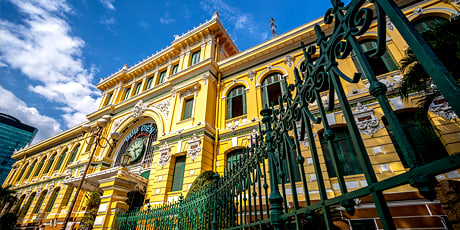 Commonly known as Saigon, this city in southern Vietnam was renamed Ho Chi Minh City in 1976 when Saigon merged with the Gia Dinh Province. Ho Chi Minh City perfectly illustrates its past and future -- full of towering skyscrapers and charming tree-lined streets. Famously known for its importance during the Vietnam War, the city is also recognized for its French influence scattered throughout. Some great examples of this influence are the Notre-Dame Cathedral, created solely with French-imported materials, the ornate French colonial Saigon Post Office that famous architect Gustave Eiffel built, and Reunification Hall, which formerly served as the Presidential Palace. Take time to visit one of the earliest surviving structures in Saigon -- Bến Thành Market. This bustling market is full of stalls and vendors selling local handicrafts, textiles, souvenirs, and cuisine. Some of the top street foods in Ho Chi Minh City are Vietnamese sandwiches, southern-style southern pancakes, and broken rice.
Commonly known as Saigon, this city in southern Vietnam was renamed Ho Chi Minh City in 1976 when Saigon merged with the Gia Dinh Province. Ho Chi Minh City perfectly illustrates its past and future -- full of towering skyscrapers and charming tree-lined streets. Famously known for its importance during the Vietnam War, the city is also recognized for its French influence scattered throughout. Some great examples of this influence are the Notre-Dame Cathedral, created solely with French-imported materials, the ornate French colonial Saigon Post Office that famous architect Gustave Eiffel built, and Reunification Hall, which formerly served as the Presidential Palace. Take time to visit one of the earliest surviving structures in Saigon -- Bến Thành Market. This bustling market is full of stalls and vendors selling local handicrafts, textiles, souvenirs, and cuisine. Some of the top street foods in Ho Chi Minh City are Vietnamese sandwiches, southern-style southern pancakes, and broken rice. Founded over 1000 years ago on the banks of the Red River, Hanoi is the capital of Vietnam (and one of the most ancient capitals in the world!) known for its centuries-old architecture and a rich culture with influences stemming from Southeast Asia, China, Russia, and France. This city is also famous for its decadent cuisine, lively nightlife, handmade crafts and silks sold in the markets, and more. With the streets of its bustling 14th-century Old Quarter, Hoan Kiem lake that lies in the heart of the capital, Ho Chi Minh's Mausoleum and his private residence, and more, Hanoi illustrates the history of Vietnam perfectly. Additionally, this capital city is home to the famous Temple of Literature, Vietnam's first university, and Hoa Lo Prison, also known as the "Hanoi Hilton."
Founded over 1000 years ago on the banks of the Red River, Hanoi is the capital of Vietnam (and one of the most ancient capitals in the world!) known for its centuries-old architecture and a rich culture with influences stemming from Southeast Asia, China, Russia, and France. This city is also famous for its decadent cuisine, lively nightlife, handmade crafts and silks sold in the markets, and more. With the streets of its bustling 14th-century Old Quarter, Hoan Kiem lake that lies in the heart of the capital, Ho Chi Minh's Mausoleum and his private residence, and more, Hanoi illustrates the history of Vietnam perfectly. Additionally, this capital city is home to the famous Temple of Literature, Vietnam's first university, and Hoa Lo Prison, also known as the "Hanoi Hilton." The One Pillar Pagoda, located in Hanoi, is a historic Buddhist temple and one of Vietnam's most iconic temples. Built by King Ly Thai, this architecturally unique structure lies on a single stone pillar in the middle of a lake built to represent a lotus (also Vietnam's national flower). According to legend, the king would visit numerous temples, praying to Buddha for a son of his own. He once dreamed of the bodhisattva Avalokiteshvara seated on a giant lotus flower in the middle of a square pond. He was holding a baby boy that he then gifted to the king. Months after this dream, the queen gave birth to a little boy. With this exciting miracle, the king commissioned the One Pillar Pagoda in 1049, which resembled a giant lotus emerging from the water.
The One Pillar Pagoda, located in Hanoi, is a historic Buddhist temple and one of Vietnam's most iconic temples. Built by King Ly Thai, this architecturally unique structure lies on a single stone pillar in the middle of a lake built to represent a lotus (also Vietnam's national flower). According to legend, the king would visit numerous temples, praying to Buddha for a son of his own. He once dreamed of the bodhisattva Avalokiteshvara seated on a giant lotus flower in the middle of a square pond. He was holding a baby boy that he then gifted to the king. Months after this dream, the queen gave birth to a little boy. With this exciting miracle, the king commissioned the One Pillar Pagoda in 1049, which resembled a giant lotus emerging from the water.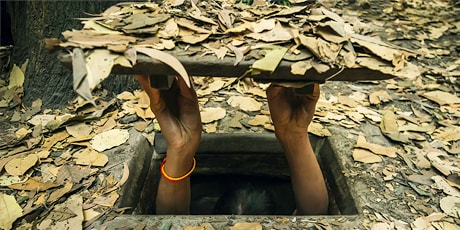 The Cu Chi Tunnels is an elaborate network of underground tunnels located in the Củ Chi District of Ho Chi Minh City and built by the Viet Minh in the 1940s. These tunnels once stretched over 200 miles and contained tactical quarters, storage rooms, kitchens, a school, and a hospital. The purpose of this underground system was to help the Vietnamese protect themselves and fight against the more well-equipped American and South-Vietnamese soldiers during the Vietnam War. The Vietnamese soldiers dug out and utilized these tunnels to house troops, transport supplies from place to place, house booby traps for enemies, and more. Most entrances to these tunnels were so well disguised that only a tiny portion of the system was ever discovered during the war. American and South-Vietnamese soldiers, known as "tunnel rats," were trained to explore the tunnels to find booby traps and enemies. Today, the Cu Chi Tunnels are in a Vietnam War memorial park and have become a popular tourist attraction; you can descend into some tunnels to see for yourself!
The Cu Chi Tunnels is an elaborate network of underground tunnels located in the Củ Chi District of Ho Chi Minh City and built by the Viet Minh in the 1940s. These tunnels once stretched over 200 miles and contained tactical quarters, storage rooms, kitchens, a school, and a hospital. The purpose of this underground system was to help the Vietnamese protect themselves and fight against the more well-equipped American and South-Vietnamese soldiers during the Vietnam War. The Vietnamese soldiers dug out and utilized these tunnels to house troops, transport supplies from place to place, house booby traps for enemies, and more. Most entrances to these tunnels were so well disguised that only a tiny portion of the system was ever discovered during the war. American and South-Vietnamese soldiers, known as "tunnel rats," were trained to explore the tunnels to find booby traps and enemies. Today, the Cu Chi Tunnels are in a Vietnam War memorial park and have become a popular tourist attraction; you can descend into some tunnels to see for yourself!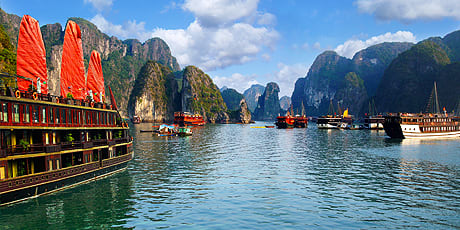 Halong Bay is a UNESCO World Heritage site adorned with thousands of limestone karsts and isles in the Gulf of Tonkin. The bay is popularly known for its sparkling emerald-green waters that are home to over 1,600 islands, mostly uninhabited. According to ancient legend, invaders came to the area to try and claim the land. To protect the land and its inhabitants, the Jade Emperor directed the Mother Dragon down to Earth to assist the locals in fighting against the invaders. As she defeated the enemies, the Mother Dragon scattered down emeralds, eventually becoming the towering limestone formations that still stand today. The name "Halong Bay" originated from this legend since "Halong" means "descending dragon." The bay is a popular destination for scuba diving, rock climbing, and hiking, especially near Cat Ba National Park.
Halong Bay is a UNESCO World Heritage site adorned with thousands of limestone karsts and isles in the Gulf of Tonkin. The bay is popularly known for its sparkling emerald-green waters that are home to over 1,600 islands, mostly uninhabited. According to ancient legend, invaders came to the area to try and claim the land. To protect the land and its inhabitants, the Jade Emperor directed the Mother Dragon down to Earth to assist the locals in fighting against the invaders. As she defeated the enemies, the Mother Dragon scattered down emeralds, eventually becoming the towering limestone formations that still stand today. The name "Halong Bay" originated from this legend since "Halong" means "descending dragon." The bay is a popular destination for scuba diving, rock climbing, and hiking, especially near Cat Ba National Park.  The Temple of Literature, Vietnam's first university, was built in 1070 during the time of Emperor Lý Thánh Tông and was closed in 1779. Today, the well-preserved architecture and gardens (that are still cared for just as they were hundreds of years ago!) paint a picture of Vietnam's past. In the university's early days, the students that attended the Temple of Literature were members of the elite class who studied literature, poetry, and Chinese philosophy. The university is divided into five different courtyards. The first two courtyards are full of towering trees and freshly manicured lawns where students could relax between classes. The second courtyard is home to the Khue Van Cac pavilion, standing tall among white stone columns and storing a brass bell that is rung only on favorable occasions. The third contains the Thien Quang well and the Stelae of Doctors. Here, students believed it was good luck to rub the Stelae statues before their exams; however, it is now forbidden to touch them to help preserve them. The fourth courtyard is where visitors and students can find altars of Confucius and his disciples. The final square was where the actual university was and is the site of numerous cultural events today.
The Temple of Literature, Vietnam's first university, was built in 1070 during the time of Emperor Lý Thánh Tông and was closed in 1779. Today, the well-preserved architecture and gardens (that are still cared for just as they were hundreds of years ago!) paint a picture of Vietnam's past. In the university's early days, the students that attended the Temple of Literature were members of the elite class who studied literature, poetry, and Chinese philosophy. The university is divided into five different courtyards. The first two courtyards are full of towering trees and freshly manicured lawns where students could relax between classes. The second courtyard is home to the Khue Van Cac pavilion, standing tall among white stone columns and storing a brass bell that is rung only on favorable occasions. The third contains the Thien Quang well and the Stelae of Doctors. Here, students believed it was good luck to rub the Stelae statues before their exams; however, it is now forbidden to touch them to help preserve them. The fourth courtyard is where visitors and students can find altars of Confucius and his disciples. The final square was where the actual university was and is the site of numerous cultural events today.